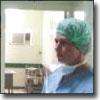Anesthesiologist Marie-Louise Linderer arrived in Baghdad in late April directly following the US occupation of Iraq to help reinforce Doctors Without Borders/Médecins Sans Frontières (MSF)'s team in the city. She worked for several days at Al Zafarania hospital in an impoverished area on the southeast edge of the capital and assessed hospitals and health centers throughout the city. Below are reflections of three days during the chaos following the end of the war.
|
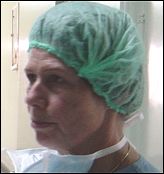
|
Monday, April 23: Visit to an ambulance station
We enter the ambulance yard behind Al Karkh hospital. We are welcomed by the supervisor, a general physician. He is very depressed.
He tells me, "We come to work everyday, the staff who can reach the center and me, but we are completely useless. The telephone system is broken, so we can't be reached, no patients can call us. Before the war we had a central number, 122, for 38 ambulance stations. Now we have some ambulances parked at the gates of the hospital so they can bring patients back from the hospital to their homes. This is not what an ambulance should do."
So from 100 ambulances in this station, there are only 40 left. The others have been destroyed or stolen, and the ones that remain have been looted as well. There are only 2 or 3 equipped cars.
They beg us for first aid kits and oxygen for their cars. We can't bring oxygen because we don't have it. But we will bring them boxes of materials so they can stock their first aid kits.
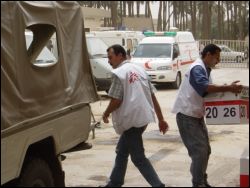
MSF donation to an ambulance service. Photo © MSF |
This ambulance station is also a teaching center. They have anatomy dolls to help train people in resuscitation, as well as plastic bodies with visible organs.
The lack of communication is the main problem. When you have an emergency, you have to go to the ambulance station and beg them to come with you to bring the patient to the hospital.
But there is another problem. Not all the drivers are trustworthy now. So sometimes the ambulance station sends a car out, and the driver doesn't return.
Tuesday, April 24: Visit to Al Wasyti hospital
This former plastic surgery hospital had no emergency room but all patients are brought here because it was the only one in the area that wasn't looted. The lobby is packed with beds and stretchers with patients. Friends and relatives crowd around them. The hall is full and there is crying and screaming and shouting. Patients arrive with fresh wounds, they arrive with infected wounds, they arrive for emergency cases and for dressings, and they arrive for emergency medical cases like heart attacks.
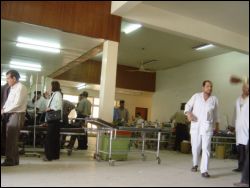
Lobby of the Al Wasyti hospital. Photo © MSF |
It is chaos everywhere.
Doctors, residents, students or who knows what go from patient to patient changing dressings with forceps, a weak disinfectant solution, no gloves. They use the same forceps for each fresh wound dressings.
We ask the staff and the patients and they tell us there is a huge need for help. They have no painkillers, so the patients are screaming. We were here yesterday, and the director was so glad MSF would help care for patients.
Today we have a meeting with the director to organize our work, but he is not here. We have to wait in an area near the makeshift emergency room. We are sitting there and I get a ghostly feeling listening to the patients scream from pain. After three hours the director arrives, says hello and that he has to go. He tells us that it isn't possible for MSF to work in the hospital. We don't know why.
Wednesday, April 24: Visit to Al Zafarania Hospital
We want to show our new logistician what we have done in Zafarania hospital. On the street are two tanks and a crowd of people. There has been an accident - an ammunition storage area has exploded. There are 10-14 wounded and 4-6 dead. As we enter the hospital we see two bloody boxes on a truck. Maybe the coffins.
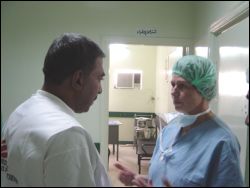
Anesthetist Marie-Louise Liderer at Al Zafarania hospital. Photo © MSF |
The entrance to the hospital is blocked by journalists. Surgeries are going on in the operating theater (OT). I talk to the staff and say I am an anesthesiologist who has worked there before and they say, "Yes, yes. There is work to do."
The anesthesiologist I worked with comes to the OT door. I offer my help, but the first thing he says is 'Thank you but we are two now. Dr. Bassan has come back so we don't need you.' I tell him I only want to help now, for this emergency.
I ask him if I could show Jean the things we had done. He brings us some OT clothes so we can enter.
The observation area I helped install is crowded with other things; there is no space for patients to be observed after an operation. Also, the observation machine with pulse rate and blood pressure is not installed because they have no wires.
We go to the first operating theater - it looks like a storage room. The new anesthesia machine they had stolen from the military hospital rests in the corner. They reinstalled the old machine, maybe for the safety of the patients because they can work better with this old machine. The safety box I installed for needles isn't being used, and the floor is covered with sutures and needles.
We go to the second theater where a patient with a bullet wound is being treated. It is hectic and there is clutter everywhere. Used syringes and needles are on the floor and on the table. The surgeons are working without a surgical nurse. The instruments are spread across the table and the surgeon has to grab the equipment himself.
We leave and go to the yards where there is material stolen from the nearby military hospital. One of the yards is locked - a pharmacist keeps the key so no one can steal the stolen drugs. The other yard is open, so we enter. The boxes are crammed but nothing is unpacked.
Frustrated and depressed, we leave the hospital. At the entrance door are three stretchers they used to bring in the wounded, dirty and bloody, a fine meal for 10,000 flies.
